For a cool-season crop, it’s pretty hard to beat beets.
They’re quick to grow, and you can have a harvest in six weeks, not to mention the tops as well as the roots are edible.
Plus, come on… they’re delicious, with that earthy, rich goodness.
As if that wasn’t enough to recommend them, they’re generally free from problems.
I say “generally” because there isn’t a single plant that I know that doesn’t have at least a few pests or diseases that they’re susceptible to.
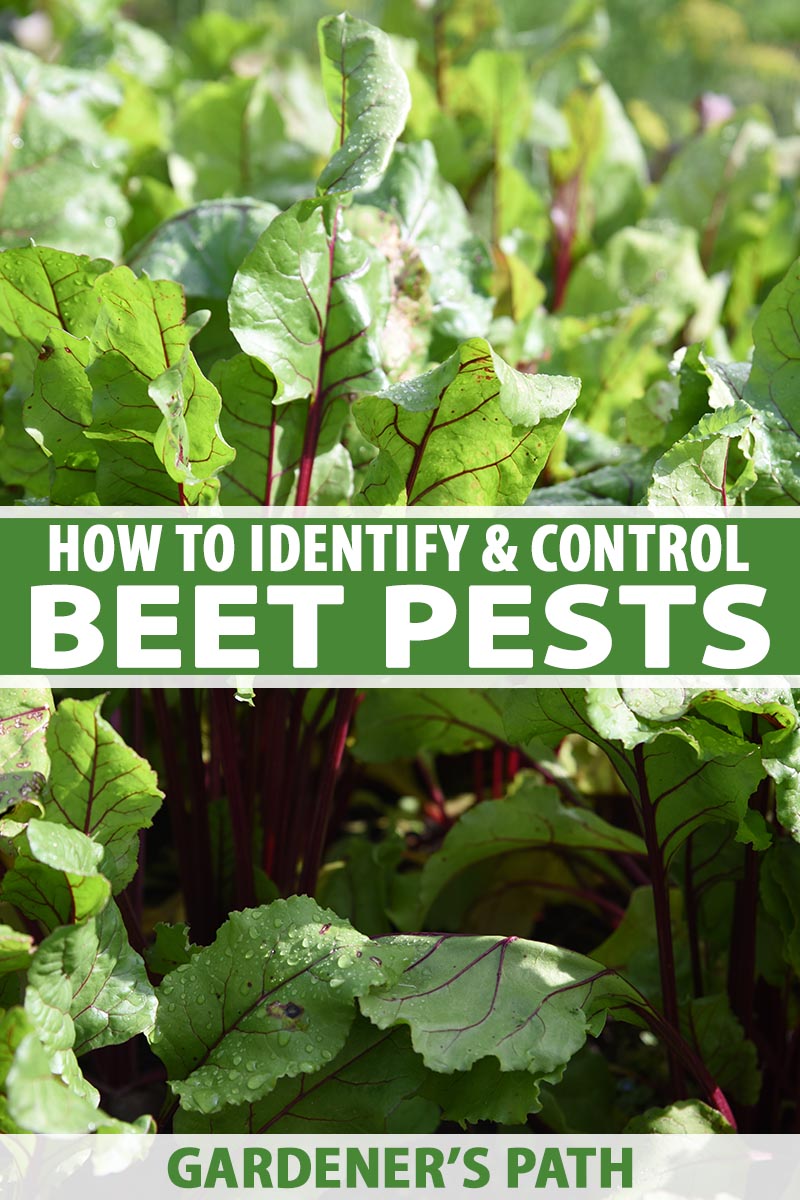
We link to vendors to help you find relevant products. If you buy from one of our links, we may earn a commission.
While you might not see them too frequently, beets definitely have their fair share of pests that will eagerly make a meal of them if conditions are right.
Here are some of the most common garden foes you might face:
13 Common Beet Pests
I know, this list looks pretty long. But don’t let that discourage you. While there are lots of bugs that may bother beets, in my experience, you won’t have to deal with them that often.
That said, if you do find yourself troubled by a creepy-crawly, this guide will help you identify it and send it packing.
1. Aphids
There are dozens of different species of aphids from the genera Myzus and Aphis that love to munch on beet plants. Green peach, melon, potato, cowpea, and bean aphids are all common.

Aphids range in color from nearly black to nearly white, with some that are tan, orange, green, or red. All are tiny and pear-shaped. Some have wings, and others don’t.
They suck on the sap of plants, leaving behind a sticky residue called honeydew, which also attracts ants and creates the perfect environment for fungi. A large infestation may cause leaves to curl and yellow. They can stunt leaf and root growth as well.
Blast the plant with a strong spray of water from the hose as your first line of attack. Sometimes you can knock them loose, and they won’t return.
You should also encourage beneficial insects like parasitic wasps, ladybugs, lacewings, soldier beetles, and syrphid flies to visit your garden.
Still have a problem? Dusting plants with flour or wiping the stems and undersides of leaves with canola oil can help.
If you decide to go the chemical route, know that insecticides can kill good insects as well as the bad ones.
Our guide to dispelling aphids can help you figure out the best options for you and your garden.
2. Beet Cyst Nematodes
Beet cyst nematodes (Heterodera schachtii) are soil-borne, microscopic organisms that can cause leaves and roots to be stunted and malformed.
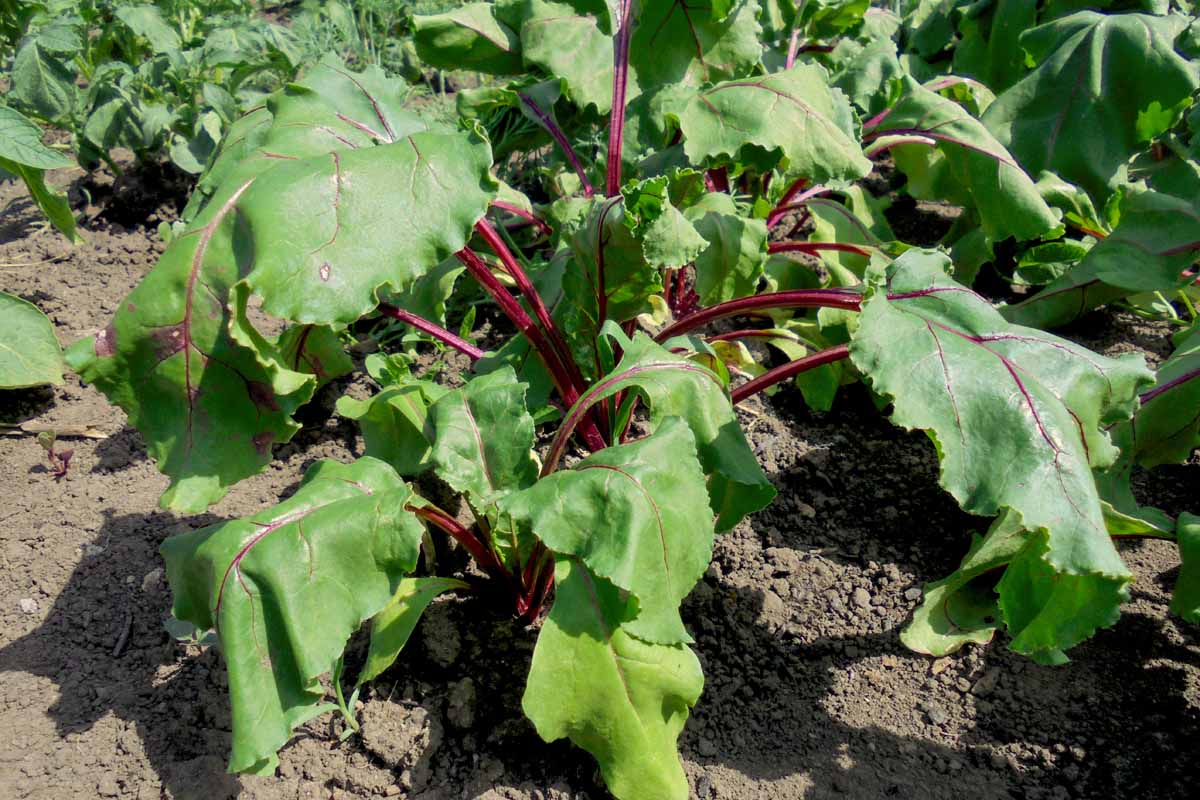
On top of that, you may see older leaves wilt and turn yellow.
If you dig up your plants and notice that the roots have yellowish cysts, along with a few of these other symptoms, you likely have a nematode problem.
If you do, there isn’t anything you can do about your existing crop, but you can prevent issues in the future.
First, dig up your soil to two feet deep and turn it over so that it’s exposed to the sun. Let it sit for a week. Do this a few times before planting there again. Solarization of the soil helps to kill off the nematodes.
Next, rotate your crops so that nothing in the Beta genus grows there for three years.
3. Beet Leafhoppers
The beet leafhopper (Circulifer tenellus) is a tiny pale green or tan bug with darker, blotchy markings. It’s about a tenth of an inch in length, with translucent wings.
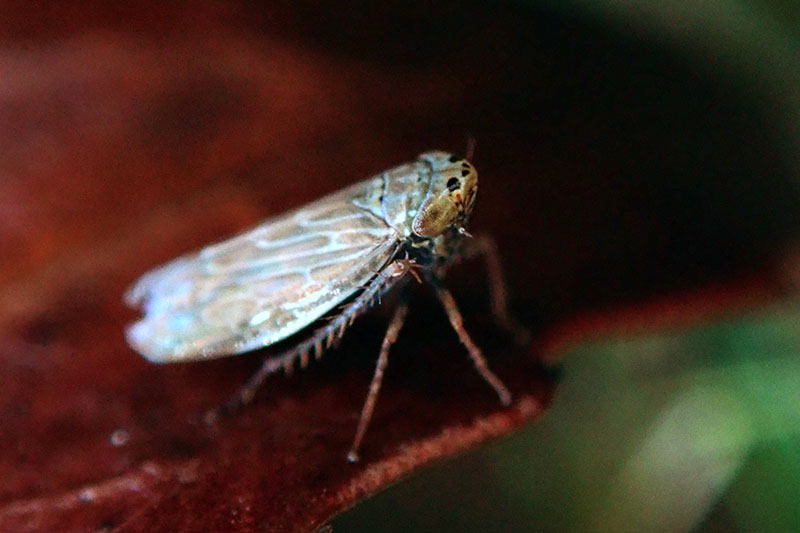
The adults will feed on the leaves, but that’s not the most pressing concern if you have these in your garden.
They spread beet curly top virus, an often devastating disease that causes plants to turn yellow and stop growing.
They’re most common in western parts of the US and Canada, and throughout Mexico.
Make sure to remove any weeds or debris from your garden in the fall at the end of the season, and in spring before planting. Then, use floating row covers while your beets are growing.
Sadly, you’ll need to pull any plants that are infected with the virus. They won’t recover from this infection and their continued presence in the garden can contribute to further spread of the disease.
4. Beet Webworms
Beet webworms are the larvae of moths in the Crambidae family.
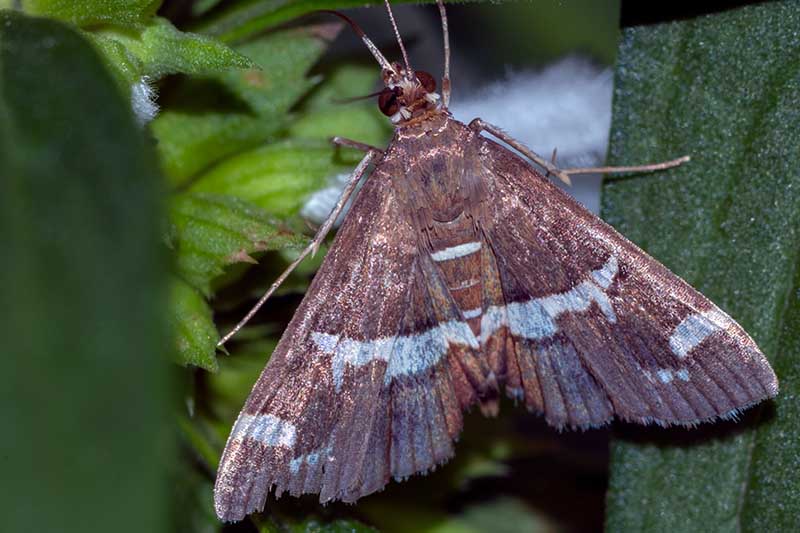
There are several different species that may attack your plants, including the spotted beet moth webworm (Hymenia perspectalis), the Southern beet moth webworm (Herpetogramma bipunctalis), Hawaiian beet moth webworms (Spoladea recurvalis), the sugar moth webworm (Loxostege sticticalis), alfalfa moth webworms (Loxostege cereralis), and the garden moth webworm (Achyra rantalis).
All of them live primarily in warmer regions, like the southern and western US, though they can travel as far north as the southern Canadian border in the summer months.
The worms chew through leaves, and they can skeletonize a plant rapidly if there are enough of them.
They also curl or bind leaves together, and use silky threads to make a cozy spot to hide. You might come outside one day and discover that your plants are covered in these nest-like webs.
However, this isn’t a nest that the worms create in order to pupate. They do that underground, where they form cocoons. Instead, these are homes where they shelter in between meals. If you look closely, you’ll likely be able to spot them hanging out inside.
Because the leaves are all bound up or chewed through, not only can this slow growth, but you won’t be able to enjoy all those tasty beet leaves if you have an infestation.
The webworms vary in appearance, with some being olive green while others are yellow or bright green, sometimes with black stripes. They range from just under an inch long to an inch and a half long.
Since they all look different, the easiest way to identify them (besides looking for the telltale curled leaves) is to disturb them.
If you try to touch one of the worms, it’ll drop from the plant by a silky thread and hang in the air.
You can also keep an eye out for tan or brown moths flitting around your vegetable patch, and put out yellow sticky traps to nab one or two so you can use the adult moth to identify which insect you’re dealing with.
Fortunately, by the time the larvae hatch and mature, beets have usually had a chance to grow enough that the roots will still be fully formed, despite any damage to the foliage above ground.
Root damage is typically rare, but if you have a severe infestation that has completely defoliated your plants, you could lose your crop.
If you don’t want to lose any beet leaves, or if you have plants that are being defoliated rapidly enough that you’re worried this could stunt root growth, you can use Bacillus thuringiensis to control them.
Just be sure to follow the manufacturer’s directions and guidelines when you apply it.
5. Blister Beetles
Blister beetles are small pests, half an inch to an inch long, that can be gray, tan, black, or red, striped or spotted. There are dozens of species in the Meloidae family that feed on plants.

The good news is, they also eat grasshopper eggs. The bad news is that they have a toxin on their exteriors called cantharidin that can irritate your skin, and harm livestock if they ingest it.
The adults feed on foliage starting in the midsummer, so if your beets are out of the ground before then, you won’t have to worry about this pest. But for summer or fall crops, be on the lookout.
Unless they’re seriously defoliating your beets, you can put on a pair of gloves and pick these pests off of plants if you see them.
Monterey Take Down Garden Spray
If your beets are heavily impacted, use a pesticide that contains pyrethrins, like Monterey Take Down Garden Spray, available at Arbico Organics.
6. Cutworms
Cutworms are the larvae of flying night moths in the Noctuidae family. They chew through the base of beet foliage at the soil level, killing the plants.

They range in color from light gray to bright green or dark brown, and if you look closely, their skin appears to have a greasy texture. All are about an inch or two long and they have no hair, unlike some other types of caterpillars.
If you disturb them, they curl up into a protective little “C” shape.
They can be hard to spot because they only come out at night. Most often, what happens is you come outside to check your garden in the morning, only to discover your beet foliage lying dead on the ground.
Some cutworms feed on young leaves and stems, in addition to cutting the stems down.
Because they can kill an entire plant overnight, you don’t want to mess around if you find you have these in the garden.
As a preventative step, start by clearing the planting area of any weeds before you sow your seeds. Throughout the growing season, be sure to keep any weeds at least three feet away from your beets.
At planting time, you should also leave a three-foot-wide bare patch of soil in between your beets and the lawn. This is important if you are growing your beets in the ground, or in raised beds that are open on the bottom, in an area near where grass is growing.
Cutworms like to hide in grass and weeds, but they won’t travel across a wide expanse of open ground that leaves them exposed.
Next, the most effective method to keep them away from your beets is also surprisingly simple: You can use cardboard or a plastic container to create a barrier. I like to use waxed milk cartons or plastic water bottles because they won’t disintegrate in the rain.
Cut the top and bottom off, leaving about four inches of the container length intact. Sink the container an inch deep into the soil, and plant your seedling or seeds in the center.
Normally, we don’t recommend transplanting beets since they’re root vegetables. But in this case, it’s worth the effort of starting seedlings in containers since the alternative could be losing your plants entirely.
To make things easier on your beet transplants, start them indoors in biodegradable pots. Then, carefully cut out the bottom of the pot without disturbing the developing root, and put the whole thing in the ground, with a protective collar around it.
You can also scatter diatomaceous earth around your plants as an added barrier, but you’ll need to reapply it frequently, after periods of rain or after watering.
Learn more about cutworm infestation prevention and control here.
7. European Corn Borers
Don’t let the name fool you – Ostrinia nubilalis loves to eat far more than just corn. And these pests don’t just live in Europe.
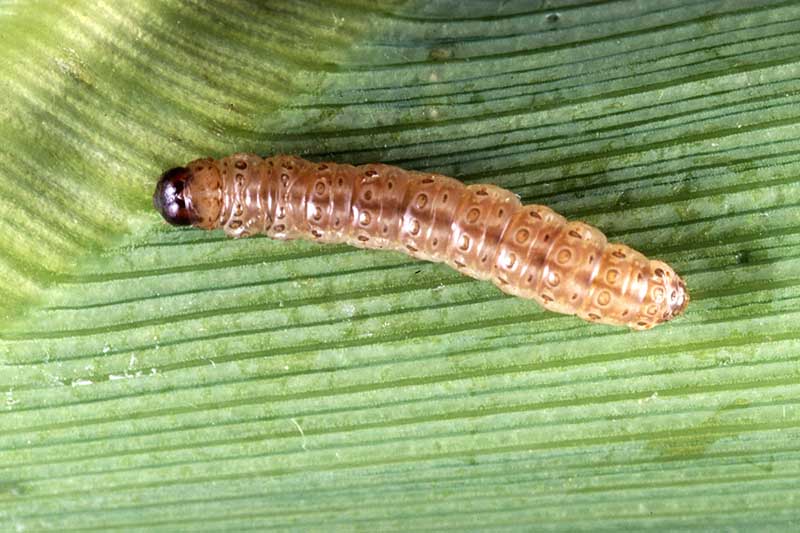
These insects first made their way to the US from Europe in the early 1900s, and now thrive everywhere east of the Rockies, from Canada down to Mexico. Many western states have a quarantine in place to try to limit their spread.
Fortunately, they only pupate on corn plants in the spring, so if you don’t have any corn growing in or near your garden, you likely won’t have to worry about them.
The larvae, which do all the damage, are pinkish-brown with black dots on their bodies and brown heads. The adults are inch-long yellow or brown moths.
While the larvae will bore into above-ground veggies like corn and peppers, they only eat the foliage on beets.
Handpick these little pests if you spot them. The bad news is that there are usually two or three generations each year, so you need to be diligent.
Lacewings and ladybugs love to munch on these pests, so do your best to encourage these beneficial insects to take up residence in your garden.
Tiny Trichogramma wasps will parasite the eggs, and you can purchase and release these garden helpers to keep corn borers under control.
You can buy parasitic wasps from Arbico Organics.
If all that fails, break out the Bacillus thuringiensis.
8. Flea Beetles
Flea beetles get their name because they jump around like fleas when you disturb them. But instead of nibbling on your furry friends, they prefer to nibble on the leaves of a range of plants, leaving behind tiny shotholes.
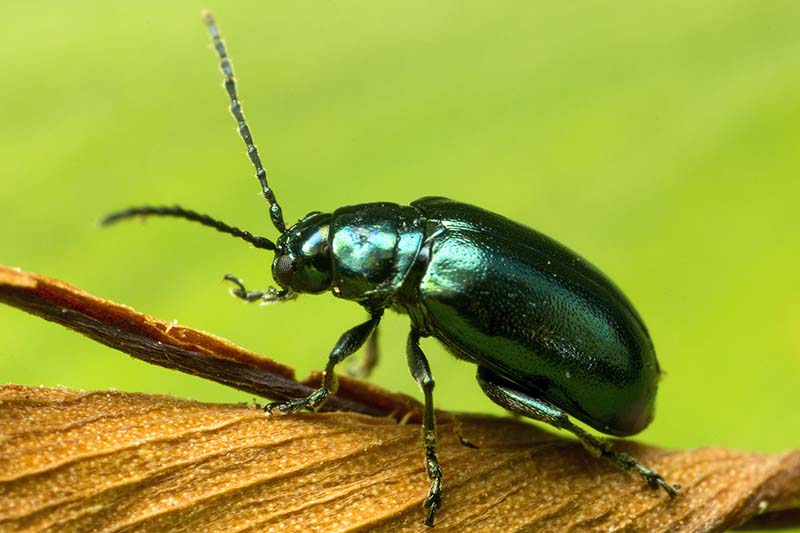
While this may not sound too bad, they can damage your beets enough that the roots will be stunted, or they can even kill your plants. Seedlings are particularly vulnerable.
There are dozens of varieties of these little bugs, but the damage they cause and available control methods are the same for all types.
Floating row covers are by far your most reliable and effective option. Put them in place when you plant your crops, and leave them there until you’re ready to harvest.
Trap crops are also effective. Plant radishes, which are a favorite of flea beetles, a few feet away from your beets to draw them away.
In addition to this, measure out about a foot from the base of your beet plants and scatter diatomaceous earth around them in a ring, creating a 12-inch “moat” around your beets.
If you have several plants, top the soil between them with diatomaceous earth and extend the DE ring a foot beyond the edge of the plants. The goal here is to create a barrier that the beetles can’t jump over, and that will kill them if they cross.
You’ll need to reapply it every few days or after rain.
Read more about flea beetles and how to eradicate them.
9. Leafminers
Leafminers are the larvae of flies from the genera Liriomyza and Pegomya. These little pests chew tunnels in winding, maze-like patterns through the leaves of beet plants.
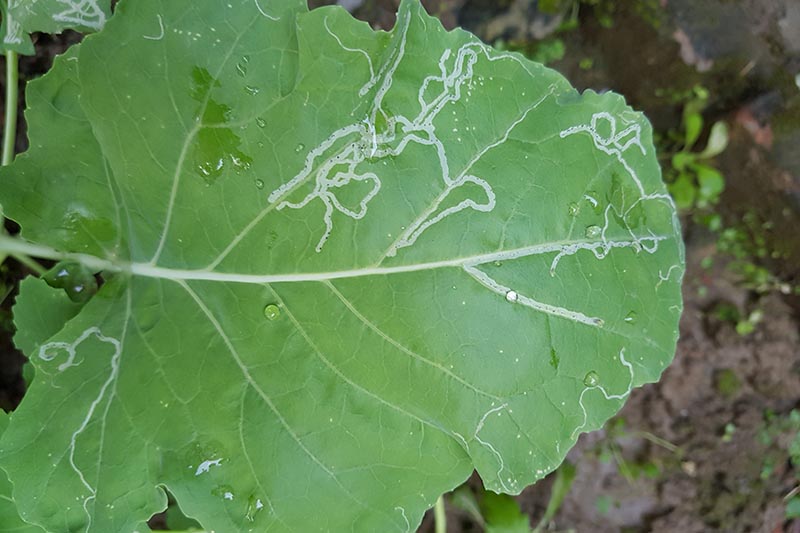
Finding a few of them isn’t really a problem. You can just crush the tunnel pathways that you find with your fingers to kill the little bugs, or remove damaged leaves.
But if they get into your plants early in the season when young seedlings are the most vulnerable, or if you have a lot of them, this can reduce the size of your beetroots and cause leaves to drop.
The really bad news? There can be up to 10 generations of these bugs each year.
Floating row covers are an effective way to keep the flies from landing on your plants and laying eggs, but you’ll need to get your covers on right when you put your seeds or seedlings in the ground, and keep them there until you harvest.
A weekly application of neem oil can also help keep them under control. Follow the manufacturer’s dosage and mixing recommendations.
Read more about controlling leafminers here.
10. Rove Beetles
Rove beetles, also known as darkling beetles, are a group of half-inch insects from the genera Blapstinus or Staphylinid that have bluish-black or dark brown carapaces.
They mostly hide during the day and pop out at night to feed on stems and seedlings.
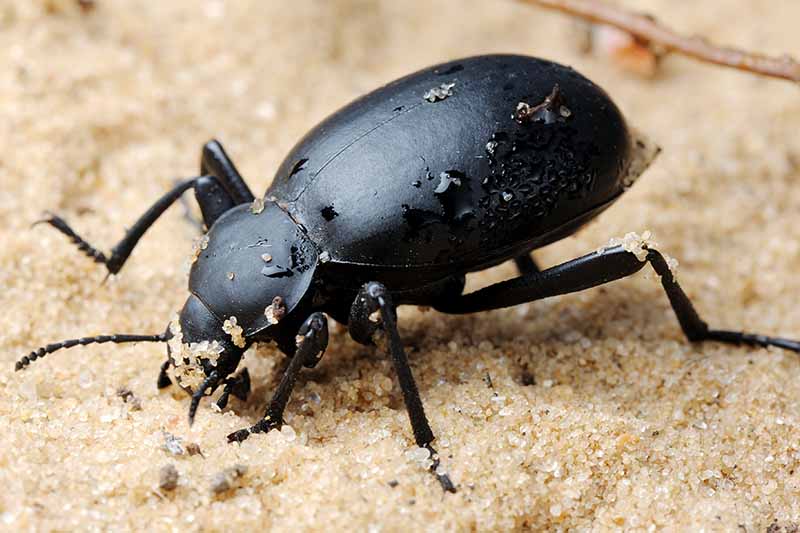
They aren’t all bad – they can help out farmers who have livestock by turning feces into usable manure. But in your vegetable patch, they aren’t so welcome.
You can dig a ditch around your garden and fill it with water to keep these bugs out. But note that you should avoid this technique during the time of year when mosquitoes are out laying their eggs, or you’ll create an ideal environment for them to reproduce.
You should also keep weeds away so they won’t have a place to hide.
While they usually aren’t a major problem, if you find that they are really doing a number on your crops, a pesticide containing carbaryl – like Sevin – will kill them.
Carbaryl is a potential carcinogen and the manufacturer recommends not to use it within seven days of harvest for roots and 14 days for greens. Personally, I would only use this as a last resort.

Ready-to-use Sevin Dust is available on Amazon.
11. Seed Corn Maggots
The seed corn maggot (Delia platura) attacks numerous crops that grow underground. These pests consume germinating seeds and can totally destroy a crop before it even gets started.
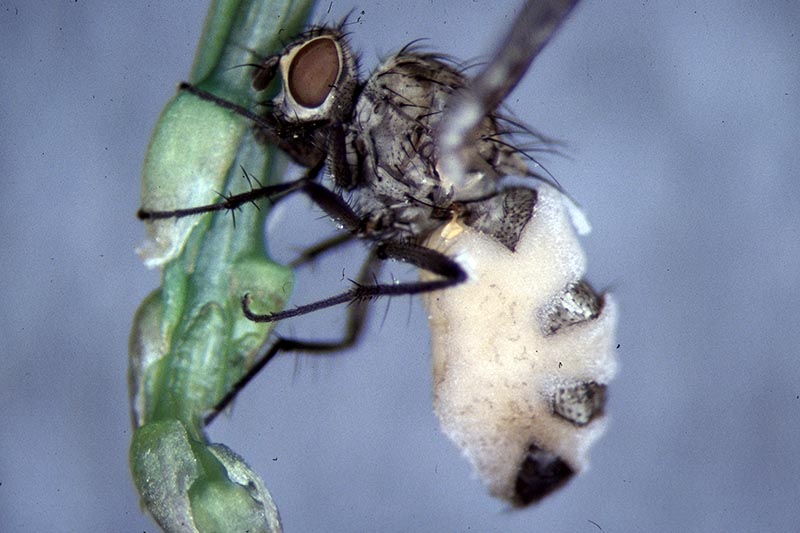
Seed corn maggots are about a quarter-inch long and whitish-yellow. The maggots overwinter in the soil and emerge in the spring to eat and reproduce. There can be up to four generations per year.
If your seedlings don’t emerge, dig the seeds up and look to see if there are maggots inside. Since the pest is larger than a beet seed, they’ll be obvious. You’ll probably see them with their heads burrowed into the seed and the rest of their body sticking out.
This is the best way to confirm that you have this pest and your seeds didn’t fail to emerge because of damping off or some other problem.
If you do have them, you can avoid problems with these pests by starting new seedlings indoors, and transplanting them outdoors when the plants are a few inches tall.
12. Spider Mites
Spider mites (Tetranychus spp.) are an extremely common and hard-to-spot pest.
While numerous species of mites will attack beets, you’ll most commonly see strawberry spider mites and two-spotted spider mites.
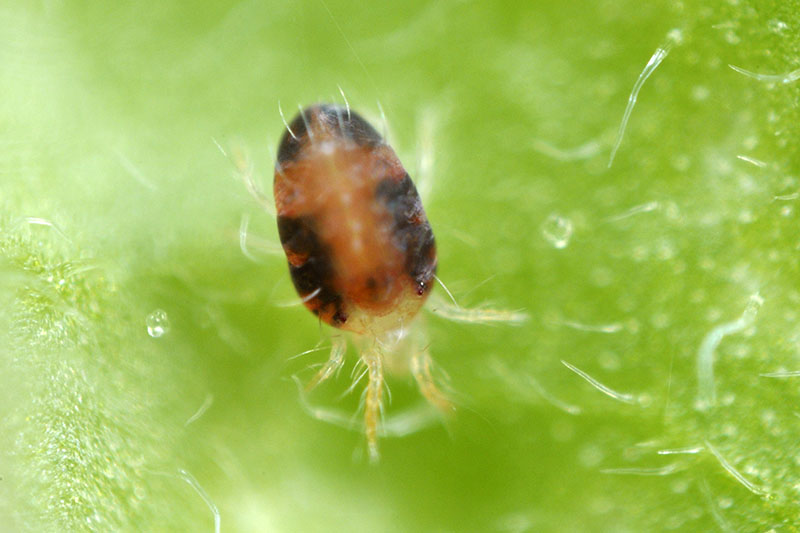
These spider relatives weave webs, which are the first things you might notice if you have an infestation.
Regardless of the variety of mite that pays your crop a visit, they all do the same type of damage. They eat from the undersides of leaves, which can cause white or yellow spots on beet foliage. This damage can eventually merge and cause leaves to drop.
Spider mites look for stressed plants, particularly those growing in hot, dry conditions. They use their needlelike mouthparts to suck the fluid out of plants.
Ladybugs, thrips, pirate bugs, and lacewings all eat spider mites. If you find an infestation, this can be a sign that their natural enemies have been eliminated from the garden, often through the use of chemical pesticides.
If you keep your beets well watered and don’t use pesticides in your garden, this will go a long way toward keeping spider mites away.
If you spot a few webs on your plants, spray them off with a strong blast of cold water. Pay attention in particular to the undersides of leaves, where mites like to hang out.
If you need something a little stronger, try a weekly application of neem oil.
13. Vegetable Maggots
Vegetable maggots (Delia radicum) feed on the roots of plants – which is bad news if you were planning to eat those roots!
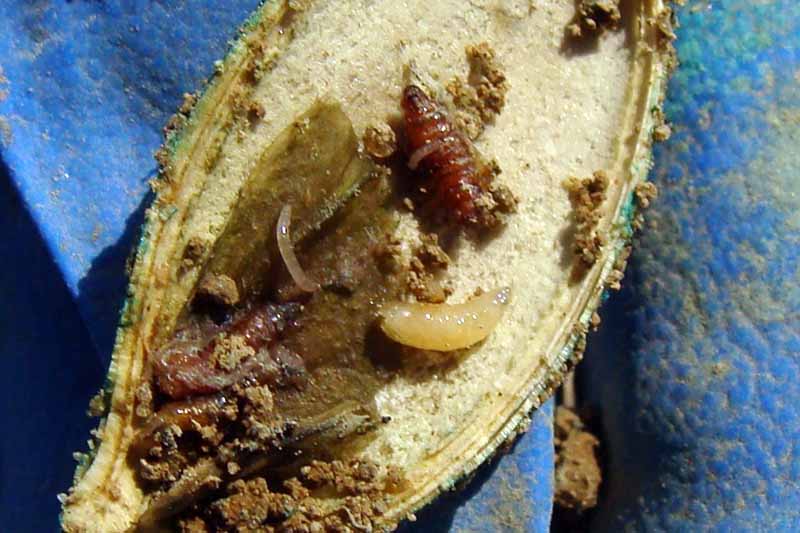
Like its cousin the seed corn maggot, this type overwinters in the soil and emerges in the spring to eat. It looks almost identical to the seed corn maggot as well, about a quarter-inch long and cream-colored.
These maggots chew tunnels into the surface of beetroots and completely devour the finer root hairs. Above ground, plants will look stunted, wilted, and weak. Leaves may turn yellow or mottled, or they may have purpling on the edges.
Not only do they damage plants, these pests can also introduce diseases.
You can place yellow sticky traps at ground level in the garden to attract the maggots. Catching a few will make it easier to identify them.
Try placing traps a few inches above the ground to catch a few adults as well. Known as cabbage or root flies, they are about a quarter-inch long, with gray-brown coloring.
To prevent an infestation, wait to transplant beets into the garden until late May to avoid the emerging maggots. If you don’t live in a cool enough climate to do this, use floating row covers in the fall and spring to prevent the adult flies from landing and laying eggs.
In the winter, till over the soil to expose the overwintering pupae.
Crop rotation will also help you to keep vegetable maggots under control. Don’t plant beets where any other beet or brassica plants have been grown for at least four years after you discover an infestation.
You’re Ready to Beat Back Beet Bugs
Okay, we can’t deny that beets may face quite a few pesky foes, but don’t let that deter you.
Infestations are uncommon, and once you know what you’re dealing with, you’re halfway to solving the problem.
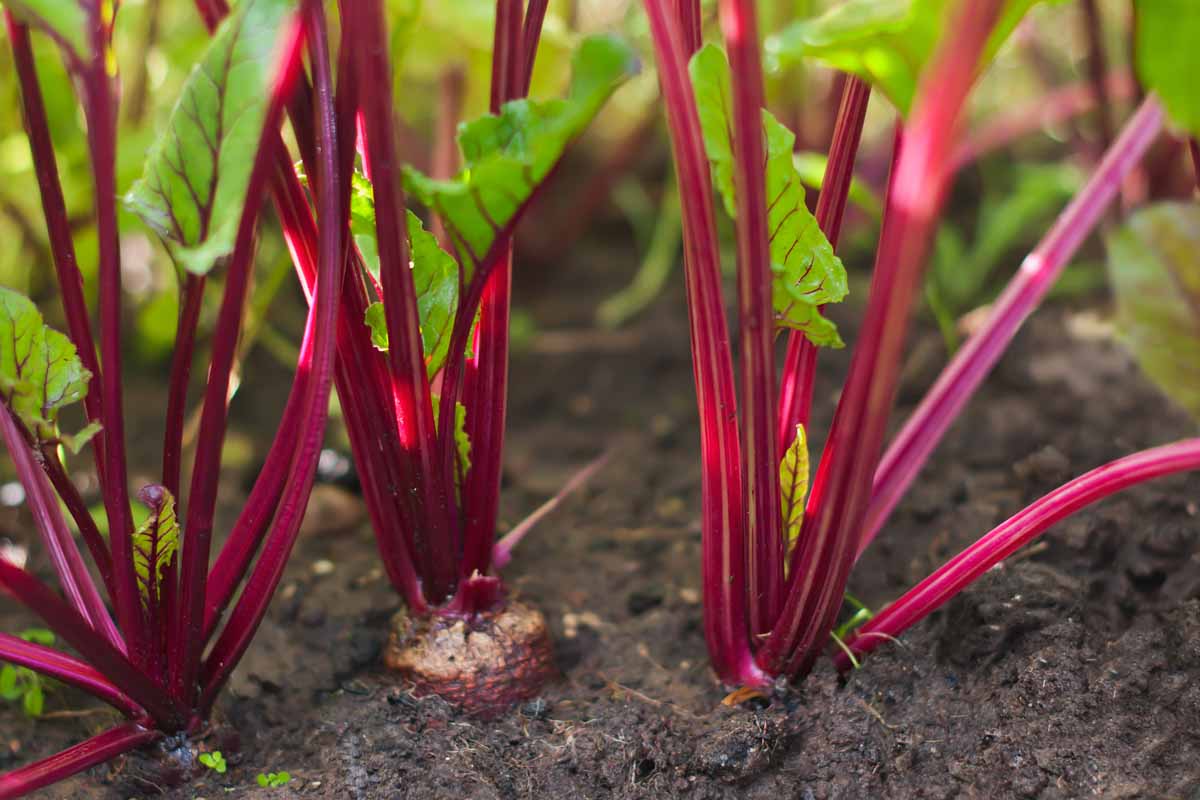
Don’t forget to follow the advice in our guide to growing beets for best gardening practices.
Let us know how it goes or if you have any trouble identifying the bugs that are bothering your beets in the comments below. The more we work together, the better we can protect our precious crops!
And for more information about growing beets in your garden, check out these guides next:
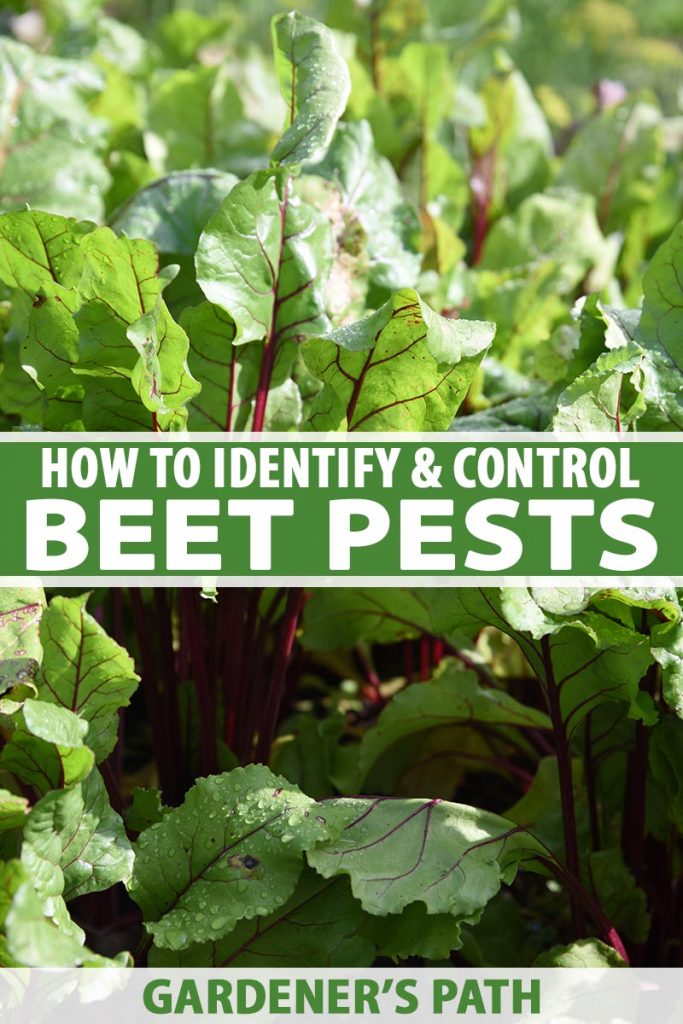




I have something eating the beet root itself. It looks like teeth marks on the root. Would you have any suggestions?
Sounds like you have voles, though it could also be field mice. If the teeth marks are on the portion of root that sticks out above the ground, it could also be rats, rabbits, or slugs.
The line of attack to take depends on whether the damage is above or below ground.
Generally, you can buy deterrents for any of the pests mentioned above.
I learn everyday here
So glad to hear that! We hope our guides are useful.
I’ve recently been picking blackberries & discovered worms or a maggot in each one! So my mind is on worm when, last night at dinner, I noticed a very white spot where I had cut my farm-fresh beet! What? Beets too?? So I did a lot if beet surgery under my magnifying glass—- I swear those are worms! As thin as sewing thread, some thicker, and 1/8″ to 1+12″ long. Please tell me I am seeing things. Are these worms in my beets?!?!
Sorry to hear it, Susan! Can you share photos? Root maggots or wireworms could be the culprit.
Hello. Please help – what could be the problem with my Swiss chard?
Fungal leaf spot disease may be the problem here. See our guide to Swiss chard disease for more info.
Carrots having whitish substance on leaves, stem and roots. What is the cause?
Can you share a photo, Seabelo? Powdery mildew is what first comes to mind, but this would appear as a powdery substance on aboveground growth – not on the roots below the soil. Take a look at our guide to growing carrots for additional assistance.
Some good info here but your persistent promotion of poisons is crazy – so passe and a serious turn-off for me and all organic gardeners. I hope you will reconsider the products you promote and start to choose healthier ones for people, plants, water, air, pollinators, pets and soil! Cheers, Lu
We never claimed to be a 100% organic website. We offer the options. It’s the CHOICE of the gardener. Some of our staff are purely organic gardeners and other prefer an Integrated Pest Management (IPM) approach which uses the least pesticides required along with beneficial organic methods. Thanks for reading. Edit: on a scan of the guide, I’m not even sure what you’re on about. Almost all suggested fixes are organic. Sevin Dust was mentioned once; yep non-organic pesticide. Bt is a bacteria, that’s organic. Floating row covers, trap crops, spraying with a hose, parasitic and other beneficial insects, etc… Read more »
Three times my beetroot have emerged and within 48 hours they have all gone. I’ve even set traps with no success and the last sowing I protected with wire netting , assuming it might have been pigeons, again without success. Now getting late to sow again!
Hi Rob, if the seedlings are vanishing entirely, it could be any number of things: slugs, snails, birds, rabbits, mice, voles, and more. Wire netting helps against several of these, but not all. When this happens, I find that starting the seeds indoors and letting them grow for a few weeks before setting them out makes all the difference.
Something is eating my beets (the root). Some have little voids near the top, some are nearly just beet shells hollowed out. Other’s look like someone was playing Jenga while eating. My garden is raised-bed w/fence, so I don’t think there are varmints getting in. Unless this could be the work of something that climbs like a squirrel? Or large quantity of root-eating bugs or worms?
Help!
Hi Brad, believe it or not, maggots can do a lot of damage in large enough numbers. Check out the section on maggots above to control them next year.